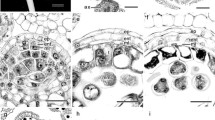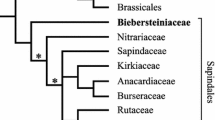Abstract
Drimys winteri (Winteraceae) and 11 species ofAnnonaceae, namelyAnnona montana, Artabotrys hexapetalus, Bocagea sp.,Papualthia sp.,Polyalthia nitidissima, Tetrameranthus umbellatus, T. duckei, Uvaria sp.,Xylopia malayana, X. aromatica, andX. emarginata, were investigated embryologically with special reference to development of ovule and embryo sac. The ovules are anatropous, crassinucellate and in most taxa bitegmic. The inner integument is of epidermal origin. TheAnnonaceae investigated have a multi-layered, later vascularized outer integument with most probably subepidermal initiation. In contrast,Drimys winteri has a three-layered, non-vascularized outer integument of epidermal origin. The annonaceous genusTetrameranthus (T. umbellatus andT. duckei) possesses a middle integument between the inner and the outer one, stated here for the first time in a neotropic representative ofAnnonaceae. Within the angiosperms this feature occurs inAnnonaceae only. The embryological characters are rather homogeneous. Differences between the species investigated are found in, e.g. the number of cell layers in the inner integument, which is commonly two inAnnonaceae as compared to three inDrimys winteri, the presence or absence of a hypostase, the number of layers in the nucellar epidermis, great differences in size of ovules, and the species-specific pattern of tannin deposition in the ovules. In the species so far investigated the embryo sacs develop according to thePolygonum-type. InXylopia malayana andBocagea sp. in addition the carpels were investigated. They are conduplicate. InXylopia malayana the free carpels are united by an “extragynoecial compitum”, inBocagea sp. each stigma produces its isolated mucilage cap. The results obtained from the investigated taxa are discussed and compared with published data on embryology and gynoecium structure in other annonaceous and winteraceous taxa.
Similar content being viewed by others
References
Bhandari, N. N., 1963: Embryology ofPseudowintera colorata — a vesselless dicotyledon. — Phytomorphology13: 303–316.
—, 1971: Embryology of theMagnoliales and comments on their relationships. — J. Arnold Arbor.52: 1–39; 285–304.
—, 1968: Embryology ofDrimys winteri. — J. Arnold Arbor.49: 509–524.
Boer, R. de, Bouman, F., 1974: Integumentary studies in thePolycarpicae. III.Drimys winteri (Winteraceae). — Acta. Bot. Neerl.23: 19–27.
Briechle-Mäck, M. H., 1994: Beiträge zur Histogenese der Blüten und Früchte pseudosynkarper Annonaceen-Arten. — Deutsche Hochschulschriften1028: 1–133.
Christmann, M., 1985: Beiträge zur Histologie der Annonaceen-Samen. — Diploma Thesis, University of Kaiserslautern, Germany.
—, 1986: Beiträge zur Histologie der Annonaceen-Samen. — Bot. Jahrb. Syst.106: 379–390.
—, 1987a: Systematische Anatomie der Annonaceen-Samen. — Dissertation, University of Kaiserslautern, Germany.
- 1987b: Genera and species ofAnnonaceae with tritegmic seeds. —Annonaceae Newslett.6: unpaged.
—, 1989: Die tritegmischen Annonaceen-Samen. — Bot. Jahrb. Syst.110: 433–439.
Corner, E. J. H., 1949: The annonaceous seed and its four integuments. — New Phytol.48: 332–364.
—, 1976: The seeds of dicotyledons,1 and2. — Cambridge: Cambridge University Press.
Deroin, T., 1988: Aspects anatomiques et biologiques de la fleur des Annonacees. — Thèse, 2 vols., Université Paris — XI, Orsay, N.590.
—, 1991: La répartition des modèles de plateaux stigmatiques et l'évolution des Annonacées. — Compt. Rend. Hebd. Séances Acad. Sci. Paris, Sér. 3, Sci. Vie.312: 561–566.
Endress, P. K., 1982: Syncarpy and alternative modes of escaping disadvantages of apocarpy in primitive angiosperms. — Taxon31: 48–52.
Freiberg, T. E., 1981:Winteraceae. — InYakovlev, M. S., (Ed.): Comparative embryology of flowering plants.Winteraceae-Juglandaceae, pp. 26–30. — Leningrad: Nauka.
Fries, R. E., 1959:Annonaceae. — InEngler, A., Prantl, K., (Eds): Die natürlichen Pflanzenfamilien, 2nd edn,17a II pp. 1–171. — Berlin: Duncker & Humblot.
Gottsberger, G., 1970: Beiträge zur Biologie von Annonaceen-Blüten. — Oesterr. Bot. Z.118: 237–279.
Herms, W. B., 1907: Contribution to the life history ofAsimina triloba. — Ohio Naturalist8: 211–217.
Herr, J. R., 1971: A new clearing squash technique for the study of ovule development in angiosperms. — Amer. J. Bot.58: 785–790.
Heusden, E. C. H. van, 1992: Flowers ofAnnonaceae: Morphology, classification and evolution. — Blumea, Suppl.7: 1–218.
Johri, B. M., Ambegaokar, K. B., Srivastava, P. S., 1992: Comparative embryology of angiosperms. — Berlin, Heidelberg, New York: Springer.
Juliano, J. B., 1935: Morphological contribution on the genusAnona Linn. — Philipp. Agric.24: 528–541.
Korobova, S. N., 1981:Annonaceae. — InYakovlev, M. S., (Ed.): Comparative embryology of flowering plants.Winteraceae-Juglandaceae, pp. 41–45. — Leningrad: Nauka.
Lampton, R. K., 1957: Floral morphology ofAsimina triloba Dunal. 1. Development of the ovule and embryo sac. — Bull. Torrey Bot. Club84: 151–156.
Leinfellner, W., 1969: Über die Karpelle verschiedenerMagnoliales. VIII. Überblick über alle Familien der Ordnung. — Oesterr. Bot. Z.117: 107–127.
Leins, P., Erbar, C., 1982: Das monokarpellate Gynoeceum vonMonodora crispata (Annonaceae). — Beitr. Biol. Pflanzen57: 1–13.
Maheshwari, P., 1950: An introduction to the embryology of angiosperms. — New York: McGraw-Hill.
Mohana Rao, P. R., 1975: Seed anatomy ofArtabotrys odoratissimus with a discussion on chalaza, integumentary bundles and ruminate endosperm. — Phytomorphology25: 215–228.
—, 1979: Seed and fruit anatomy inPolyalthia longifolia (Annonaceae). — Bot. Jahrb. Syst.101: 83–89.
—, 1982: Seed and fruit anatomy inAsimina triloba, with a discussion on the affinities ofAnnonaceae. — Bot. Jahrb. Syst.103: 47–57.
Morawetz, W., 1986: Systematics and karyoevolution inMagnoliidae:Tetrameranthus as compared with otherAnnonaceae genera of the same chromosome number. — Pl. Syst. Evol.154: 147–173.
—, 1987: Different evolutionary strategies in theAnnona-Rollinia-group. —Annonaceae Newslett.6: 1–6; Figs. 1–7.
—, 1993a: An unusualAnnonacea from SE Brazil. —Annonaceae Newslett.9: 62–64.
—, 1993b: Eine Art derMagnoliales ungesicherter Stellung aus SO-Brasilien. — InFürnkranz, D., Schantl, H., (Eds): Abstr., 11. Symp. Morph., Anat., Syst., Salzburg 1993, p. 76. — Salzburg.
Nicolosi-Roncati, F., 1905: Sviluppo dell'ovulo e del seme nella “Anona cherimolia Mill.” — Atti Accad. Gioenia Sci. Nat. Catania (4)18 (Mem. 2): 1–26.
Oes, A., 1914: Beiträge zur Entwicklungsgeschichte der Anonaceen. — Verh. Naturf. Ges. Basel25: 168–178.
Periasamy, K., 1962: The ruminate endosperm: Development and types of rumination. — In: Plant embryology. A symposium, pp. 62–74. — New Delhi: Council of Scientific and Industrial Research.
—, 1956: The conduplicate carpel ofCananga odorata. — J. Arnold Arbor.37: 366–372.
—, 1961: Studies in theAnnonaceae. II. The development of ovule and seed inCananga odorata andMiliusa wightiana. — J. Indian Bot. Soc.40: 206–216; pl. 6.
Pijl, L. van der, 1953: On the flower biology of some plants from Java with general remarks on fly-traps. — Ann. Bogor.1: 77–99.
Prakash, N., Lim, A. L., Sampson, F. B., 1992: Anther and ovule development inTasmannia (Winteraceae). — Austral. J. Bot.40: 877–885.
Sampson, F. B., 1963: The floral morphology ofPseudowintera, the New Zealand member of the vessellessWinteraceae. — Phytomorphology13: 403–423.
Sastri, R. L. N., 1957a: Floral morphology and embryology of someRanales. — D. Sc. Thesis (unpubl.), Andhra University Waltair, India.
—, 1957b: The vascularization of the ovules inSaccopetalum tomentosum. — Curr. Sci.26: 183.
—, 1969: Comparative morphology and phylogeny of theRanales. VII.Annonaceae. — Biol. Rev. Cambridge Philos. Soc.44: 291–319.
Schnarf, K., 1931: Vergleichende Embryologie der Angiospermen. — Berlin: Borntraeger.
Soerodikoesoemo, W., 1970: Development of the embryosac in some cauliflorous plants. — Ann. Bogor.5: 93–98.
Stark, L., 1929: Beiträge zur Embryologie der Annonaceen. — Ph. D. Thesis, University of Vienna, Austria.
Steinecke, H., 1993: Embryologische, morphologische und systematische Untersuchungen ausgewählterAnnonaceae. — Diss. Bot.205: 1–237.
Strasburger, E., 1905: Die Samenanlage vonDrimys Winteri und die Endospermbildung bei Angiospermen. — Flora95: 215–231.
Svoma, E., 1993a: Anatomische und funktionelle Aspekte der Samenentwicklung beiAnnonaceae. — InFürnkranz, D., Schantl, H., (Eds): Abstr., 11. Symp. Morph., Anat., Syst., Salzburg 1993, p. 45. — Salzburg.
—, 1993b: Contribution to the ontogenetic development and organization ofAnnonaceae seeds. —Annonaceae Newslett.9: 67–70.
—, 1997: Seed development and function inArtabotrys hexapetalus (Annonaceae). — Pl. Syst. Evol.207: 205–223.
—, 1998: Seed morphology and anatomy in someAnnonaceae. — Pl. Syst. Evol.209: 177–204.
-Morawetz, W., 1991: Beiträge zur Embryologie einigerMagnoliidae. — In: Abstr., 10. Symp. Morph., Anat., Syst., Göttingen 1991, p. 76. — Göttingen.
Swamy, B. G. L., 1952: Some aspects in the embryology ofZygogynum bailloni V. Tiegh. — Proc. Natl. Inst. Sci. India18B: 399–406.
Westra, L. Y. T., 1985: Studies inAnnonaceae. IV. A taxonomic revision ofTetrameranthus R. E. Fries. — Proc. Kon. Ned. Akad. Wetensch., C88: 449–482.
Author information
Authors and Affiliations
Rights and permissions
About this article
Cite this article
Svoma, E. Studies on the embryology and gynoecium structures inDrimys winteri (Winteraceae) and someAnnonaceae . Pl Syst Evol 209, 205–229 (1998). https://doi.org/10.1007/BF00985229
Received:
Revised:
Accepted:
Issue Date:
DOI: https://doi.org/10.1007/BF00985229




